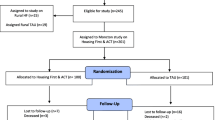Abstract
We examined individual and group characteristics associated with the duration of community involvement (i.e., length of residence) in 11 Illinois Oxford Houses for 129 male recovering addicts. Survival analyses indicated that the best predictor of duration of community involvement from demographic items was age (i.e., older age and older age of fellow residents were associated with being more likely to continue residence). Among psychological measures, the best survival predictor was lack of pessimism of the future. Although the relationship between longer length of residence and treatment outcomes are complex, because it is often difficult to keep people involved in treatment programs, knowledge that we can gain about those factors that might lead to greater lengths of stay are of importance.
Similar content being viewed by others
REFERENCES
Armor, D. J., Polich, J. M., & Stambul, H. B. (1978). Alcoholism and treatment. Report R-1739-NIAAA. Santa Monica, CA: Rand Corp.
Bachrach, K. M., & Zautra, A. J. (1985). Coping with a community stressor: The threat of a hazardous waste facility. Journal of Health and Social Behavior, 26, 127–141.
Baumeister, R. F., & Leary, M. R. (1995). The need to belong: Desire for interpersonal attachments as a fundamental human motivation. Psychological Bulletin, 117, 497–529.
Bishop, P. D., Chertok, F., & Jason, L. A. (1997). Measuring sense of community: Beyond local boundaries. Journal of Primary Prevention, 18, 193–212.
Dvorchak, P., Grams, G., Tate, L., & Jason, L. A. (1995). Pregnant and post-partum women in recovery: Barriers to treatment and the role of Oxford House in the continuing of care. Alcoholism Treatment Quarterly, 13, 97–107.
Fals-Stewart, W., & Schafer, J. (1992). The relationship between length of stay in drug-free therapeutic communities and neurocognitive functioning. Journal of Clinical Psychology, 48, 539–543.
Ferrari, J. R., Curtin, M., Dvorchak, P., & Jason, L. A. (1997). Recovering from alcoholism in communal-living settings: Exploring characteristics of African Americans. Journal of Substance Abuse, 9, 77–87.
Ferrari, J. R., & Dobis, K. (1997). Effects of mandatory versus volunteer service to children on college student development and a sense of community. Manuscript under review.
Ferrari, J. R., Sobroski, S., & Boyer, P. (1997). Honor versus college student community-service to Latino youths and their sense of community. Manuscript under review.
Humphreys, K., & Woods, M. D. (1993). Researching mutual help group participation in a segregated society. The Journal of Applied Behavioral Science, 29, 181–201.
Jason, L. A., Ferrari, J. R., Groessl, E. J., Dvorchak, P. A., & Malloy, J. P. (1997). The characteristics of alcoholics in self-help residential treatment settings: A multi-site study of Oxford House. Alcoholism Treatment Quarterly, 15, 53–63.
Jason, L. A., Ferrari, J. R., Smith, B., Marsh, P., Dvorchak, P. A., Groessl, E. J., Pechota, M. E., Curtin, M., Bishop, P. D., Kot, E., & Bowden, B. S. (1997). An exploratory study of male recovering substance abusers living in a self-help, self-governed setting. Journal of Mental Health Administration, 24, 332–339.
Jason, L. A., & Kobayashi, R. B. (1995). Community building: Our next frontier. Journal of Primary Prevention, 15, 195–208.
Jason, L. A., Pechota, M. E., Bowden, B. S., Kohner, K., Pokorny, S. B., Bishop, P. D., Quintana, E., Sangerman, C., Salina, D., Taylor, S., Lesondak, L., & Grams, G. (1994). Oxford House: Community living is community healing. In J. A. Lewis (Ed.) Addictions: Concepts and strategies for treatment (p. 333–338). Gaithersburg, MD: Aspen.
Longabaugh, R., Beattie, M., Noel, N., Stout, R. L., & Malloy, P. (1993). The effects of social investment on treatment outcome. Journal of Studies on Alcohol, 54, 465–478.
Luke, D. A., Roberts, L., & Rappaport, J. (1993). Individual, group context, and individual-group fit predictors of self-help group attendance. Journal of Applied Behavioral Science, 29, 214–236.
McCuster, J., Stoddard, A., Frost, R., & Zorn, M. (1996). Planned versus actual duration of drug abuse treatment. Journal of Nervous and Mental Disease, 184, 482–489.
Nealon-Woods, M. A., Ferrari, J. R., & Jason, L. A. (1995). Twelve-step program use among Oxford House residents: Spirituality or social support in sobriety. Journal of Substance Abuse, 7, 311–318.
Norusis, M. J. (1993). SPSS for Windows Advanced Statistics Release, 6.0. Chicago: SPSS.
Pfeiffer, S. I., O'Malley, D. S., & Shott, S. (1996). Factors associated with the outcome of adults treated in psychiatric hospitals. A synthesis of findings. Psychiatric Services, 47, 263–269.
Pretty, G. M. H. (1990). Relating psychological sense of community to social climate characteristics. Journal of Community Psychology, 18, 60–65.
Robinson, D., & Wilkinson, D. (1995). Sense of community in a remote mining town: Validating a neighborhood cohesion scale. American Journal of Community Psychology, 23, 137–148.
Schmale, A. H., & Engel, G. L. (1967). The giving up complex illustrated on film. Archives of General Psychiatry, 17, 135–145.
Singer, J. D., & Willett, J. B. (1991). Modeling the days of our lives: Using survival analysis when designing and analyzing longitudinal studies of duration and the timing of events. Psychological Bulletin, 110, 268–290.
Staats, S. (1987). Hope: Expected positive affect in an adult sample. Journal of Genetic Psychology, 148, 357–364.
Staats, S. (1989). Hope: A comparison of two self-report measures for adults. Journal of Personality Assessment, 53, 366–375.
Swindle, R. W., Phibbs, C. S., Paradise, M. J., & Recine, B. P. (1995). Inpatient treatment for substance abuse patients with psychiatric disorders. A national study of determinants of readmission. Journal of Substance Abuse, 7, 79–97.
Vaillant, G. E. (1983). The natural history of alcoholism. Cambridge, MA: Harvard University Press.
Author information
Authors and Affiliations
Rights and permissions
About this article
Cite this article
Bishop, P.D., Jason, L.A., Ferrari, J.R. et al. A Survival Analysis of Communal-Living, Self-Help, Addiction Recovery Participants. Am J Community Psychol 26, 803–821 (1998). https://doi.org/10.1023/A:1022241712065
Issue Date:
DOI: https://doi.org/10.1023/A:1022241712065




